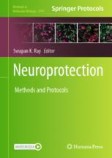Search
Search Results
-
Pinocembrin-7-Methylether Protects SH-SY5Y Cells Against 6-Hydroxydopamine-Induced Neurotoxicity via Modulating Nrf2 Induction Through AKT and ERK Pathways
The present study aimed to evaluate the neuroprotective effects and underlying mechanisms of pinocembrin-7-methylether (PME), a natural bioflavonoid,...

-
Combatting Nitrosative Stress and Inflammation with Novel Substituted Triazinoindole Inhibitors of Aldose Reductase in PC12 Cells Exposed to 6-Hydroxydopamine Plus High Glucose
Cellular redox dysregulation produced by aldose reductase (AR) in the presence of high blood sugar is a mechanism involved in neurodegeneration...

-
RETRACTED ARTICLE: Dopaminergic Neuronal Death in Substantia Nigra Associates with Serum Levels of Total Bilirubin, Selenium, and Zinc: Evidences from 6-Hydroxydopamine Animal Model of Parkinson’s Disease
Mild to moderate dopaminergic (DA) neuronal death in substantia nigra pars compacta (SNc) as the main pathological hallmark of Parkinson’s disease...

-
6-Hydroxydopamine: a far from simple neurotoxin
6-Hydroxydopamine (6-OHDA), which is a neurotoxin that selectively destroys catecholaminergic nerves in sympathetically innervated tissues, has been...

-
Pycnogenol ameliorates motor function and gene expressions of NF-ƙB and Nrf2 in a 6-hydroxydopamine-induced experimental model of Parkinson’s disease in male NMRI mice
We investigated the effect of Pycnogenol as an antioxidant on improving motor function, depression, and the expression of NF- ƙ B and Nrf2 genes in the...

-
Intranasal delivery of mitochondria for treatment of Parkinson’s Disease model rats lesioned with 6-hydroxydopamine
The feasibility of delivering mitochondria intranasally so as to bypass the blood–brain barrier in treating Parkinson's disease (PD), was evaluated...

-
Establishment of a 6-OHDA Induced Unilaterally Lesioned Male Wistar Rat Model of Parkinson’s Disease
Robust preclinical models of Parkinson’s disease (PD) are valuable tools for understanding the biology and treatment of this complex disease....
-
Loss of Collapsin Response Mediator Protein 4 Attenuates 6-Hydroxydopamine-Induced Impairments in a Mouse Model of Parkinson’s Disease
Parkinson's disease (PD) is a chronic neurodegenerative disorder characterized by impaired motor symptoms induced by the degeneration of dopaminergic...

-
Activation of p62-Keap1-Nrf2 Pathway Protects 6-Hydroxydopamine-Induced Ferroptosis in Dopaminergic Cells
Parkinson’s disease (PD) is a common neurodegenerative disorder primarily caused by the death of dopaminergic neurons in the substantia nigra pars...

-
Abscisic acid decreases expression of COX-2 and TNF-α proteins in SH-SY5Y neuroblastoma cells as an in vitro model of Parkinson's disease
Parkinson's disease (PD) is one of the most common motor disorders in humans, associated with damage to the dopaminergic cells in the brain....
-
Multi-circuit Recording in Animal Models of Parkinson's Disease
One of the main features of Parkinson’s disease is the neurodegeneration of the dopaminergic neurons of the substantia nigra pars compacta which...
-
Polyphenols from Toona sinensiss Seeds Alleviate Neuroinflammation Induced by 6-Hydroxydopamine Through Suppressing p38 MAPK Signaling Pathway in a Rat Model of Parkinson’s Disease
Polyphenols from Toona sinensis seeds (PTSS) have demonstrated anti-inflammatory effects in various diseases, while the anti-neuroinflammatory...

-
Cytotoxicity Models in Chromaffin Cells to Evaluate Neuroprotective Compounds
Primary cultures of bovine chromaffin cells are considered a good model to evaluate potential neuroprotective compounds for two major reasons: (i)...
-
Chondroitinase ABC reduces dopaminergic nigral cell death and striatal terminal loss in a 6-hydroxydopamine partial lesion mouse model of Parkinson’s disease
BackgroundParkinson’s disease (PD) is characterised by dopaminergic cell loss within the substantia nigra pars compacta (SNc) that leads to reduced...

-
Comparative proteomics study of mitochondrial electron transport system modulation in SH-SY5Y cells following MPP+ versus 6-OHDA-induced neurodegeneration
Parkinson’s disease (PD) is the second-most common neurodegenerative disease worldwide. Several studies have investigated PD for decades; however,...

-
Carvacrol Protects Against 6-Hydroxydopamine-Induced Neurotoxicity in In Vivo and In Vitro Models of Parkinson’s Disease
Parkinson’s disease (PD) is a progressive neurodegenerative movement disorder characterized by selective loss of dopaminergic neurons that project...

-
Impact of Liver Sympathetic Nervous System on Liver Fibrosis and Regeneration After Bile Duct Ligation in Rats
The sympathetic nervous system (SNS) affects many functions of the body. SNS fibers regulate many aspects of liver function, repair, and...

-
Lipid Analysis of the 6-Hydroxydopamine-Treated SH-SY5Y Cell Model for Parkinson’s Disease
Parkinson’s disease (PD) is a highly prevalent neurodegenerative disease for which no disease-modifying treatments are available, mainly because...

-
Combination of Human Mesenchymal Stem Cells and Repetitive Transcranial Magnetic Stimulation Enhances Neurological Recovery of 6-Hydroxydopamine Model of Parkinsonian’s Disease
Background:Repetitive transcranial magnetic stimulation (rTMS) has been in use for the treatment of various neurological diseases, including...

